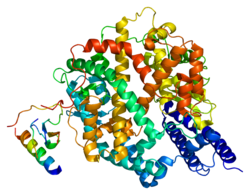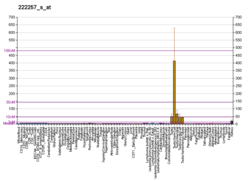
Back إنزيم محول للأنجيوتنسين 2 Arabic انزيم محول للانجيوتنسين 2 ARZ Enzim conversiu de l'angiotensina 2 Catalan ACE2 Welsh ACE2 Danish Angiotensin-konvertierendes Enzym 2 German Enzima convertidora de angiotensina 2 Spanish Angiotensinaren entzima bihurtzailea 2 Basque آنزیم ۲ مبدل آنژیوتانسین Persian Angiotensiinikonvertaasi 2 Finnish
Angiotensin-converting enzyme 2 (ACE2)[5] is an enzyme that can be found either attached to the membrane of cells (mACE2) in the intestines, kidney, testis, gallbladder, and heart or in a soluble form (sACE2).[6][7][8] Both membrane bound and soluble ACE2 are integral parts of the renin–angiotensin–aldosterone system (RAAS) that exists to keep the body's blood pressure in check. mACE2 is cleaved by the enzyme ADAM17 in a process regulated by substrate presentation. ADAM17 cleavage releases the extracellular domain creating soluble ACE2 (sACE2).[9] ACE2 enzyme activity opposes the classical arm of the RAAS by lowering blood pressure through catalyzing the hydrolysis of angiotensin II (a vasoconstrictor peptide which raises blood pressure) into angiotensin (1–7) (a vasodilator).[8][10][11] Angiotensin (1-7) in turns binds to MasR receptors creating localized vasodilation and hence decreasing blood pressure.[12] This decrease in blood pressure makes the entire process a promising drug target for treating cardiovascular diseases.[13][14]
mACE2 also serves as the entry point into cells for some coronaviruses, including HCoV-NL63, SARS-CoV, and SARS-CoV-2.[5] The SARS-CoV-2 spike protein itself is known to damage the endothelium via downregulation of ACE2.[15] The human version of the enzyme can be referred to as hACE2.[16]
- ^ a b c GRCh38: Ensembl release 89: ENSG00000130234 – Ensembl, May 2017
- ^ a b c GRCm38: Ensembl release 89: ENSMUSG00000015405 – Ensembl, May 2017
- ^ "Human PubMed Reference:". National Center for Biotechnology Information, U.S. National Library of Medicine.
- ^ "Mouse PubMed Reference:". National Center for Biotechnology Information, U.S. National Library of Medicine.
- ^ a b "Gene: ACE2, angiotensin I converting enzyme 2". National Center for Biotechnology Information (NCBI). U.S. National Library of Medicine. 2020-02-28.
- ^ Hikmet F, Méar L, Edvinsson Å, Micke P, Uhlén M, Lindskog C (July 2020). "The protein expression profile of ACE2 in human tissues". Molecular Systems Biology. 16 (7): e9610. doi:10.15252/msb.20209610. PMC 7383091. PMID 32715618.
- ^ Hamming I, Timens W, Bulthuis ML, Lely AT, Navis G, van Goor H (June 2004). "Tissue distribution of ACE2 protein, the functional receptor for SARS coronavirus. A first step in understanding SARS pathogenesis". The Journal of Pathology. 203 (2): 631–637. doi:10.1002/path.1570. PMC 7167720. PMID 15141377.
- ^ a b Donoghue M, Hsieh F, Baronas E, Godbout K, Gosselin M, Stagliano N, et al. (September 2000). "A novel angiotensin-converting enzyme-related carboxypeptidase (ACE2) converts angiotensin I to angiotensin 1-9". Circulation Research. 87 (5): E1–E9. doi:10.1161/01.RES.87.5.e1. PMID 10969042.
- ^ Lambert DW, Yarski M, Warner FJ, Thornhill P, Parkin ET, Smith AI, et al. (August 2005). "Tumor Necrosis Factor-α Convertase (ADAM17) Mediates Regulated Ectodomain Shedding of the Severe-acute Respiratory Syndrome-Coronavirus (SARS-CoV) Receptor, Angiotensin-converting Enzyme-2 (ACE2)". Journal of Biological Chemistry. 280 (34): 30113–30119. doi:10.1074/jbc.M505111200. PMC 8062222. PMID 15983030.
- ^ Keidar S, Kaplan M, Gamliel-Lazarovich A (February 2007). "ACE2 of the heart: From angiotensin I to angiotensin (1-7)". Cardiovascular Research. 73 (3): 463–469. doi:10.1016/j.cardiores.2006.09.006. PMID 17049503.
- ^ Wang W, McKinnie SM, Farhan M, Paul M, McDonald T, McLean B, et al. (August 2016). "Angiotensin-Converting Enzyme 2 Metabolizes and Partially Inactivates Pyr-Apelin-13 and Apelin-17: Physiological Effects in the Cardiovascular System". Hypertension. 68 (2): 365–377. doi:10.1161/HYPERTENSIONAHA.115.06892. PMID 27217402. S2CID 829514.
- ^ Chamsi-Pasha MA, Shao Z, Tang WH (March 2014). "Angiotensin-converting enzyme 2 as a therapeutic target for heart failure". Current Heart Failure Reports. 11 (1). Springer Science and Business Media LLC: 58–63. doi:10.1007/s11897-013-0178-0. PMC 3944399. PMID 24293035.
The discovery of ACE2 and its role in counteracting the effect of Ang-II through Ang(1-7) formation ... An imbalance in ACE2/Ang-(1–7) and ACE/Ang-II axes is critical in the development of cardiovascular diseases. The central role of ACE2, therefore, appears to counter ACE activity by reducing Ang-II bioavailability and increasing Ang(1-7) formation ... The use of RAS-modulating agents and molecules as novel therapeutic agents in hypertension and cardiovascular therapeutic research.
- ^ Chamsi-Pasha MA, Shao Z, Tang WH (March 2014). "Angiotensin-converting enzyme 2 as a therapeutic target for heart failure". Current Heart Failure Reports. 11 (1). Springer Science and Business Media LLC: 58–63. doi:10.1007/s11897-013-0178-0. PMC 3944399. PMID 24293035.
Studies with recombinant human ACE2 (rhACE2) have shown beneficial cardiac effects [18, 36]. rhACE2 has anti-fibrotic properties and can attenuate effect on systolic and diastolic dysfunction, presumably via Ang-II inhibition.
- ^ Mascolo A, Urbanek K, De Angelis A, Sessa M, Scavone C, Berrino L, et al. (March 2020). "Angiotensin II and angiotensin 1-7: which is their role in atrial fibrillation?". Heart Failure Reviews. 25 (2). Springer Science and Business Media LLC: 367–380. doi:10.1007/s10741-019-09837-7. PMID 31375968. S2CID 199388175.
the possibility of using the A1-7 or ACE2 analogues, to enlarge current therapeutic options for AF, may represent an important field of research.
- ^ Lei Y, Zhang J, Schiavon CR, He M, Chen L, Shen H, et al. (April 2021). "SARS-CoV-2 Spike Protein Impairs Endothelial Function via Downregulation of ACE 2". Circulation Research. 128 (9): 1323–1326. doi:10.1161/CIRCRESAHA.121.318902. PMC 8091897. PMID 33784827.
- ^ Kasmi Y, Khataby K, Souiri A (2019). "Coronaviridae: 100,000 Years of Emergence and Reemergence". In Ennaji MM (ed.). Emerging and Reemerging Viral Pathogens: Fundamental and Basic Virology Aspects of Human, Animal and Plant Pathogens. Vol. 1. Elsevier. p. 135. ISBN 978-0-12-819400-3.
© MMXXIII Rich X Search. We shall prevail. All rights reserved. Rich X Search






